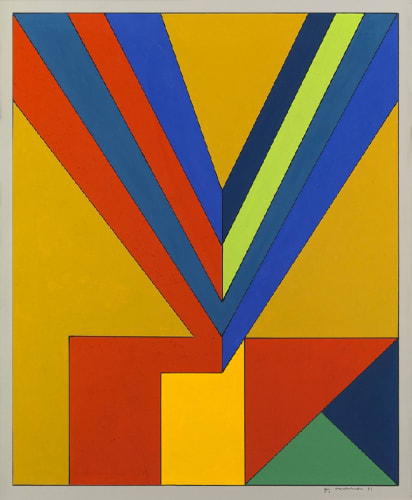Guy Vandenbranden is a Belgian visual artist considered as one of the second-generation Belgian constructivists, who achieved a complete geometric abstraction, following the steps of Piet Mondriaan (De Stijl) and of Victor Vasarély (Op Art).
Vandenbranden artistic career began at the L’Effort academy in Brussels, which was frequented by artists who loathe the prevailing academic art of painting of that time. Having started by creating abstract assemblages, reliefs and objects, with a sober colour palette and many grey shades, in the late fifties Vandenbranden evolved to purely abstract-geometric paintings in which he wanted the artistic expression to be determined solely by the visual means themselves: lines, planes and colours. His paintings became chromatically more complex, yet, without abandoning strict geometric lines. Spatiality is achieved by cross-cutting the brightly coloured planes; combinations with broad, black lines give his work an emotional tension.
In the fifties and sixties Vandenbranden was a member of the Belgian Art Abstrait and Art Construit groups and co-founder of Formes and De Nieuwe Vlaamse School, i.e. movements propagating geometric abstract art with a theoretical basis.
From the late seventies onwards, Vandenbranden also started to work on monumental commissions that included the integration of his work within the architecture. Guy Vandenbranden’s work is included in the collections of the Royal Museum of Fine Arts in Antwerp and Brussels and the museums of Liege and Verviers and has exhibited at the Museum of Contemporary Art Antwerp (MuHKA) in Belgium.
